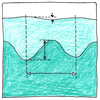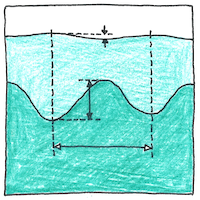Carl-Gustaf Rossby
oceanography

|
Rossby wave
Low slow waves rise inches or yards and cross the seas from east to west in months or years.
On a spinning planet
Air or water on a spinning planet has zero vorticity at the equator and increasing vorticity nearer and nearer to the poles, clockwise in the north and counterclockwise in the south, and will conserve its potential vorticity when displaced north or south. Displacement of a parcel of ocean toward the north pole results in a clockwise vortex, which moves water on its west side northward pushing the thermocline down and water to the east side southward pulling the thermocline up and results in a westward wave.
Atmospheric waves
A planet’s atmosphere conserves its potential vorticity, so Rossby waves appear to make the jet stream meander.
Distant
You can’t see them with, as it were, the naked eye. They’re too big, too slow, too subtle, too silent, too distant. Satellite altimetry can show them stealthily crossing the seas. If you close your eyes, as it were, the noise would recede.



In physics, liquids and gases are both fluids and obey the same physical laws, including conservation of vorticity.
The thermocline is the layer in a body of water that divides the upper layer that is mixed by waves from calm water below.
See also in The book of science:
Readings in wikipedia:
Other readings: